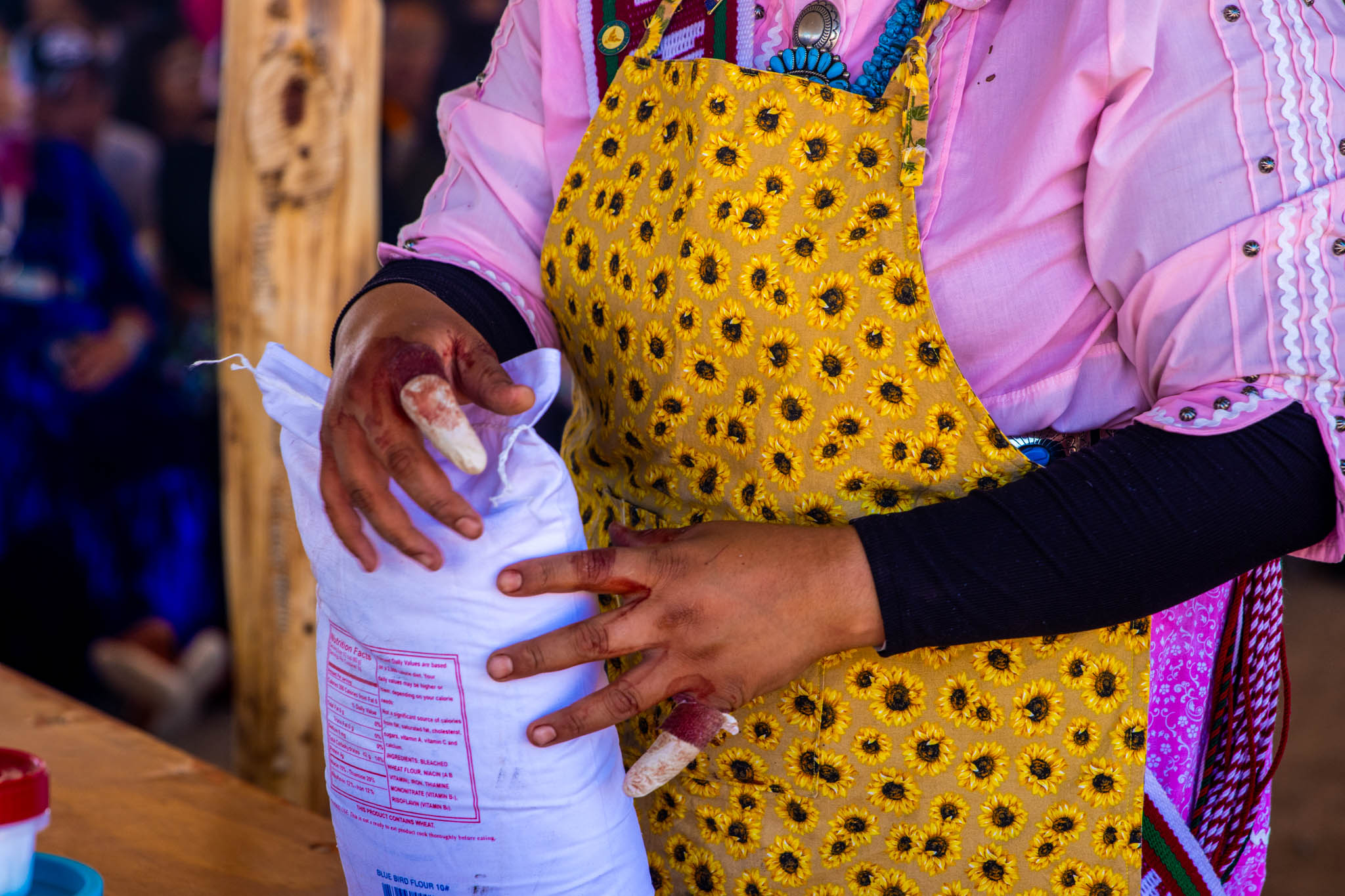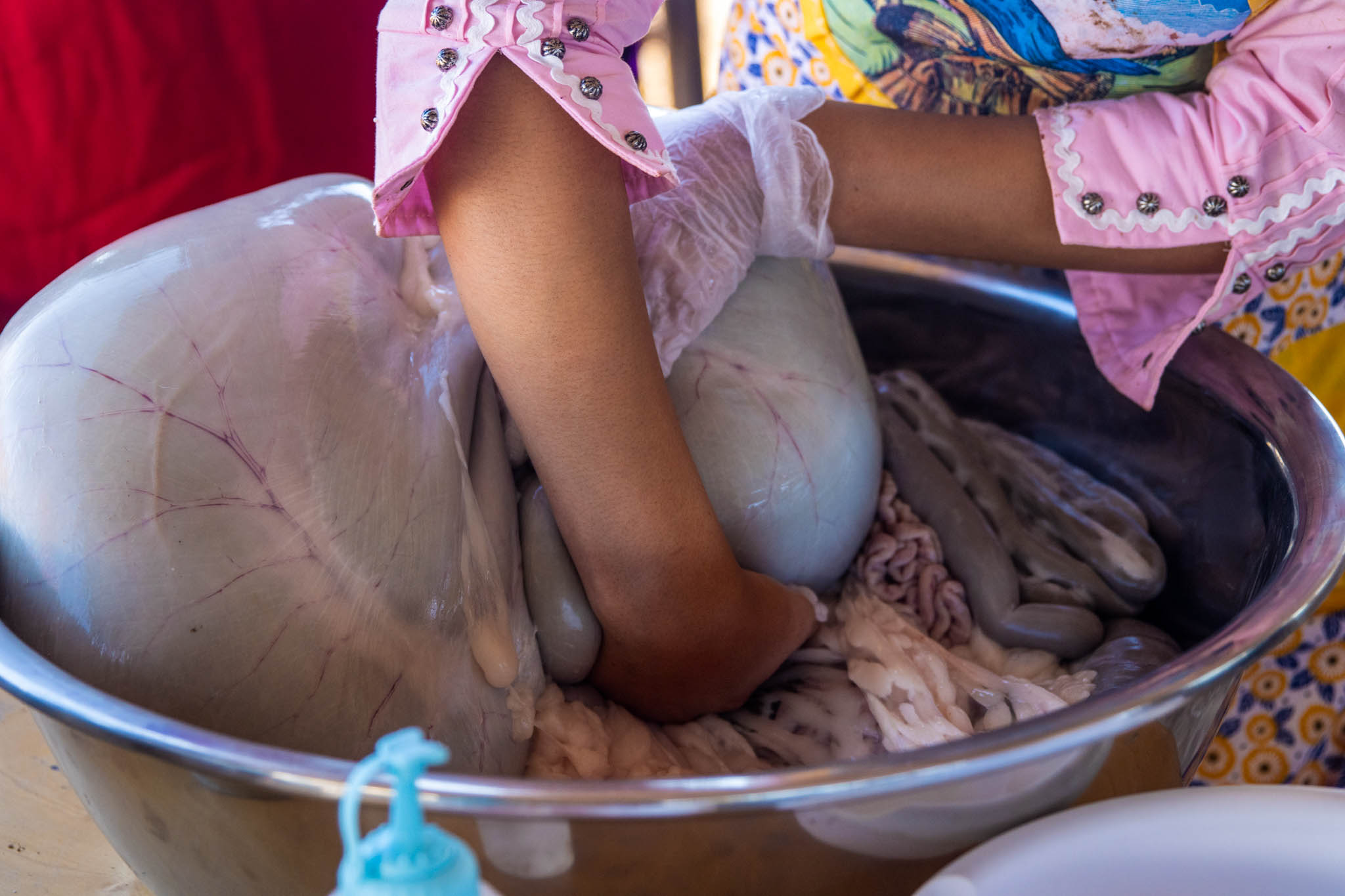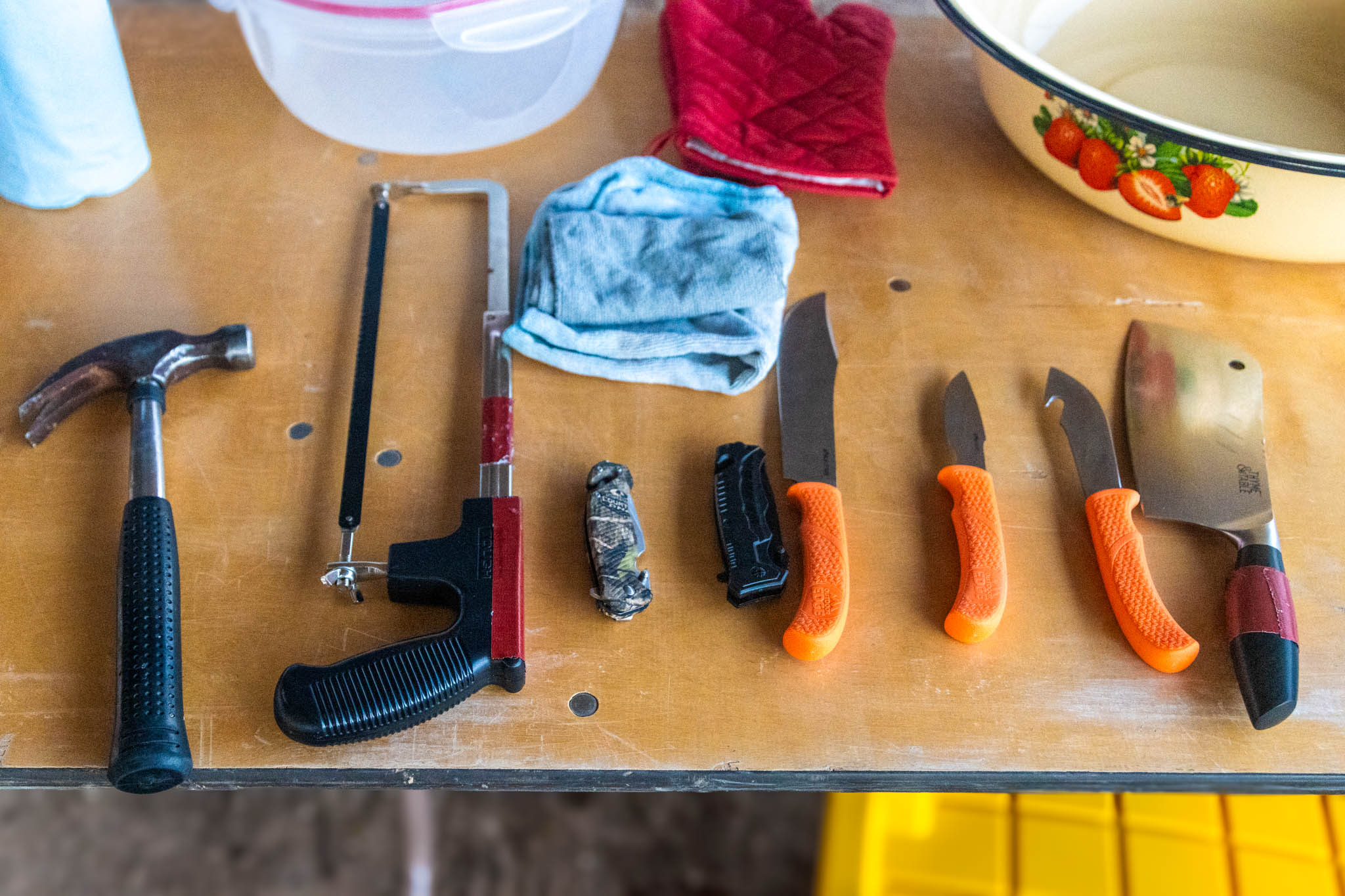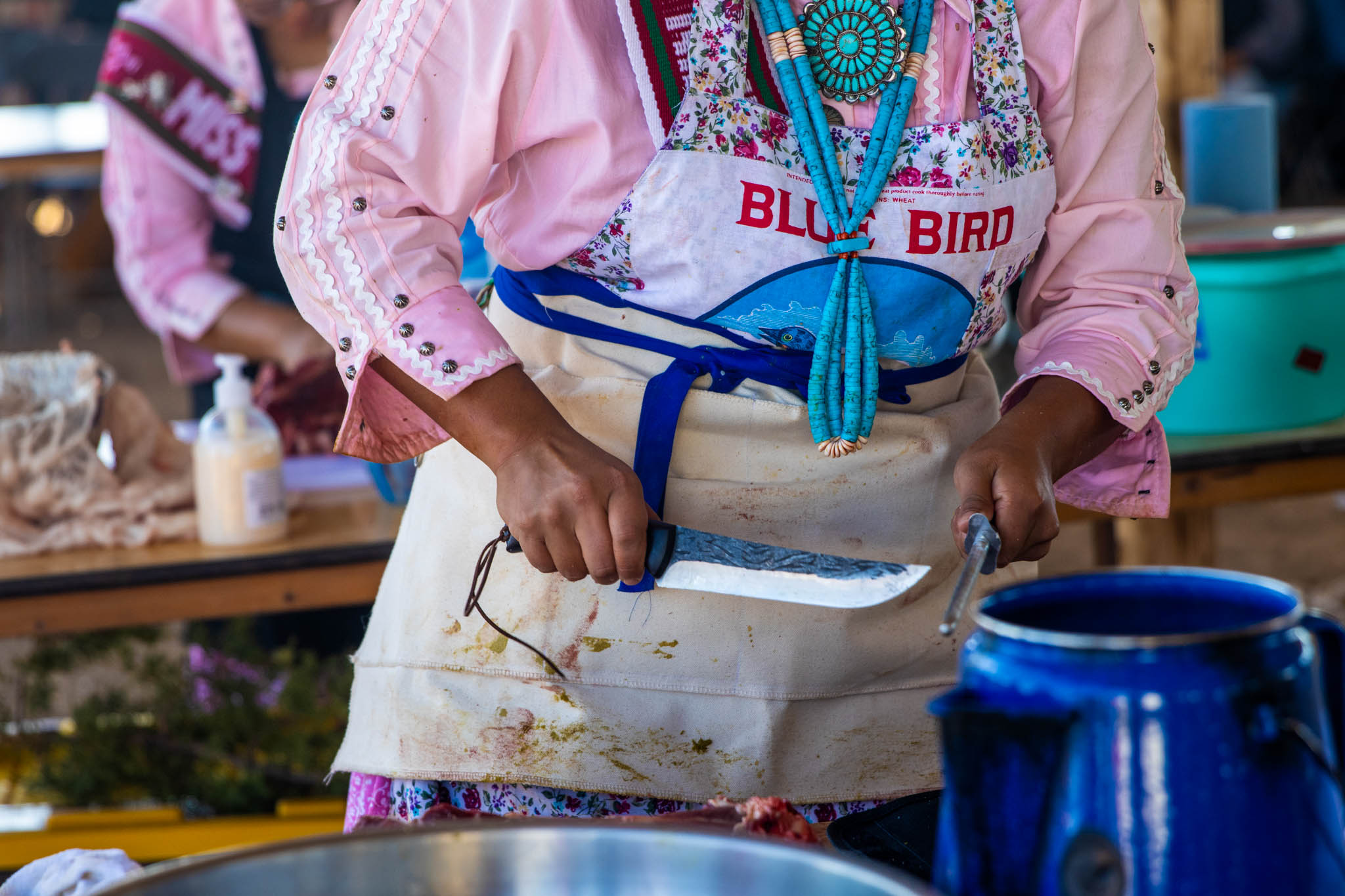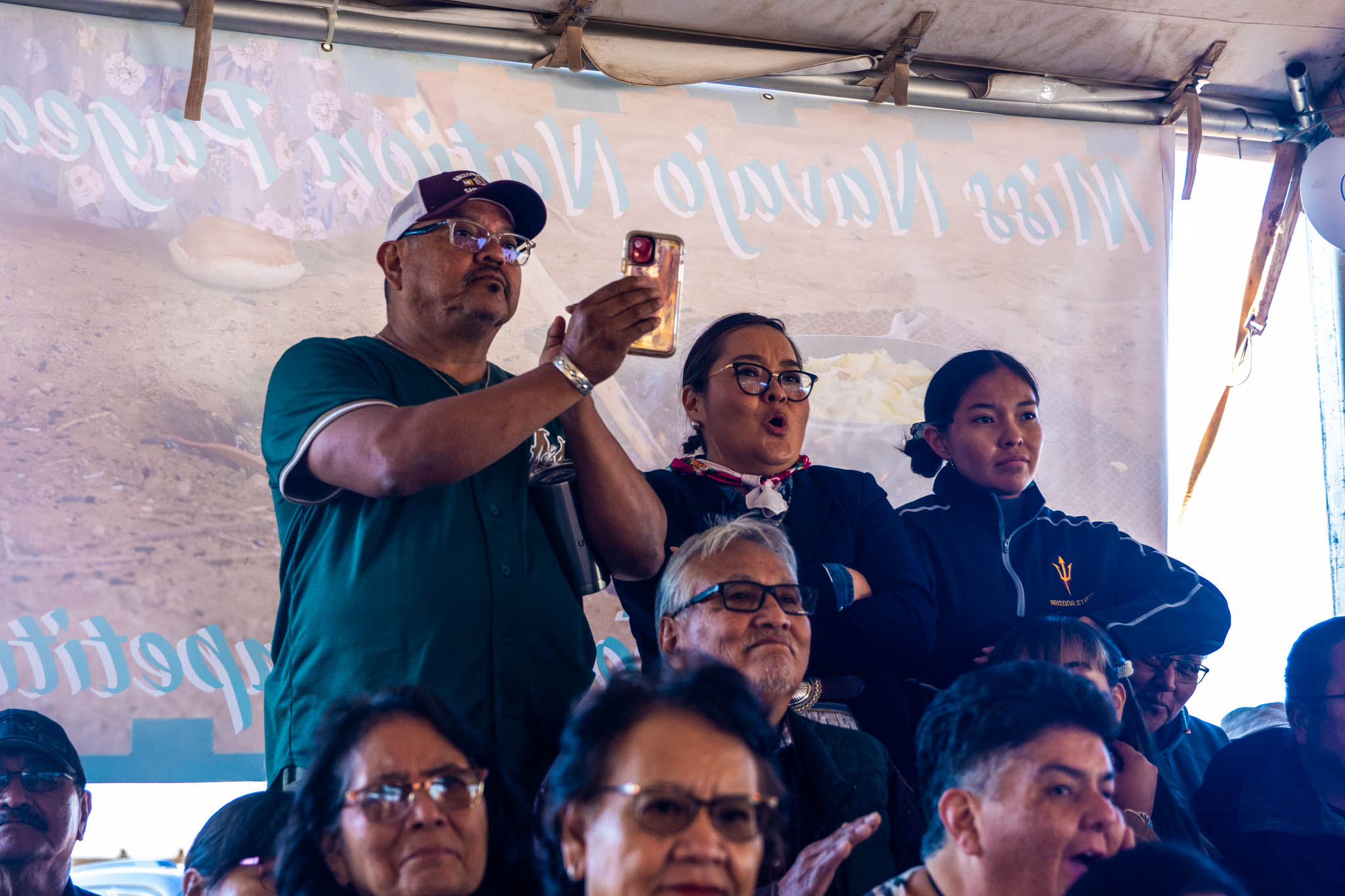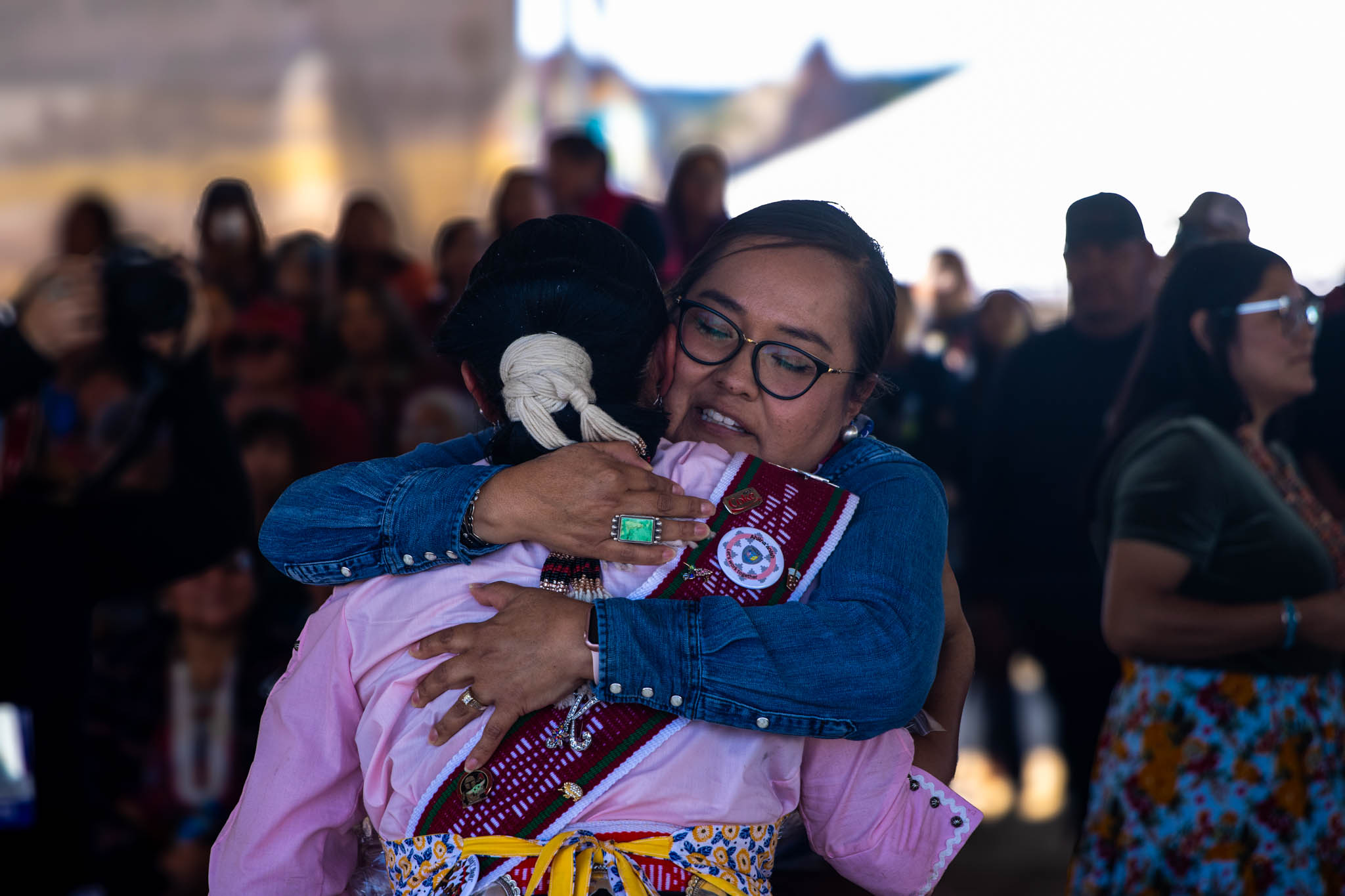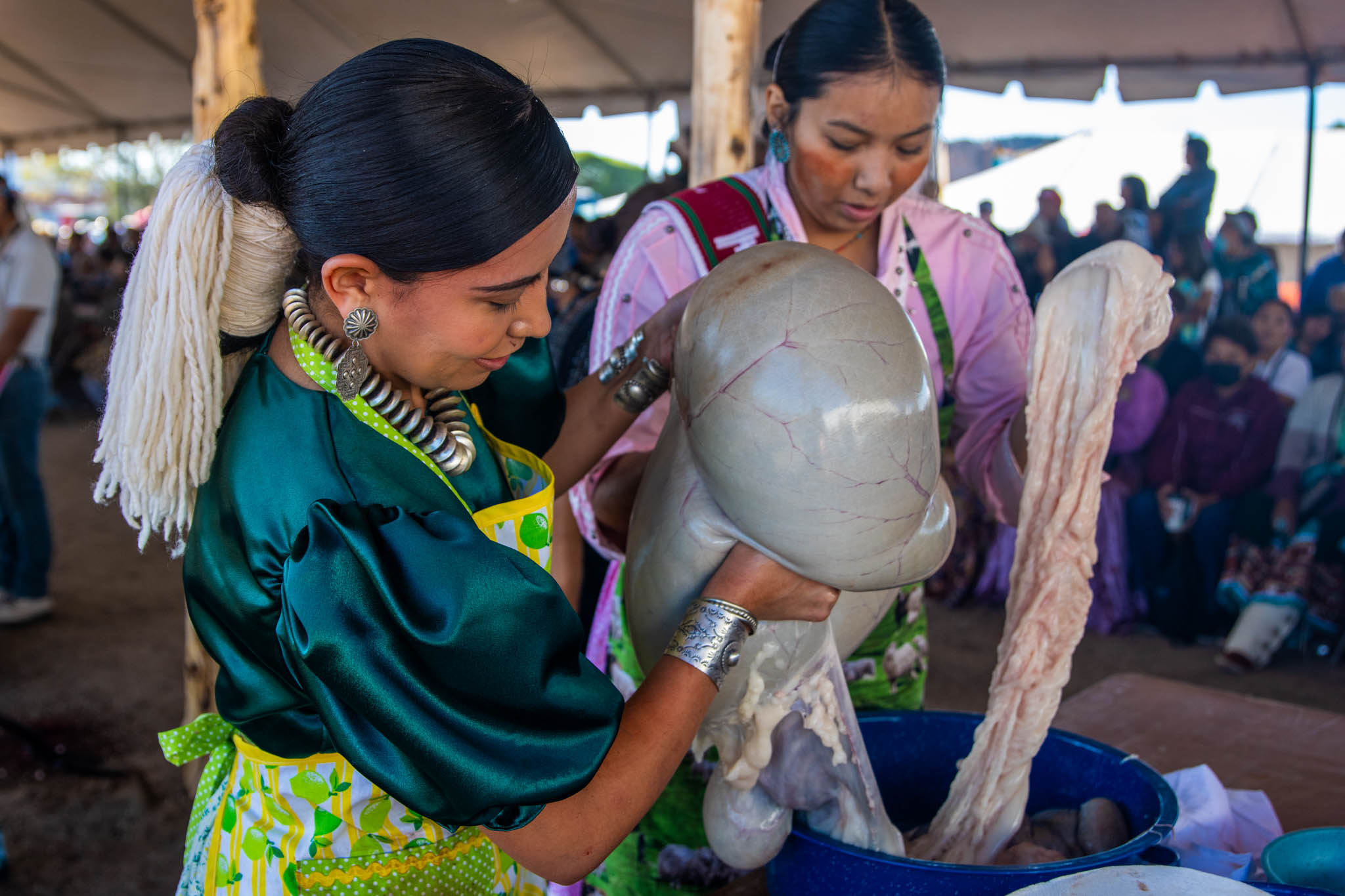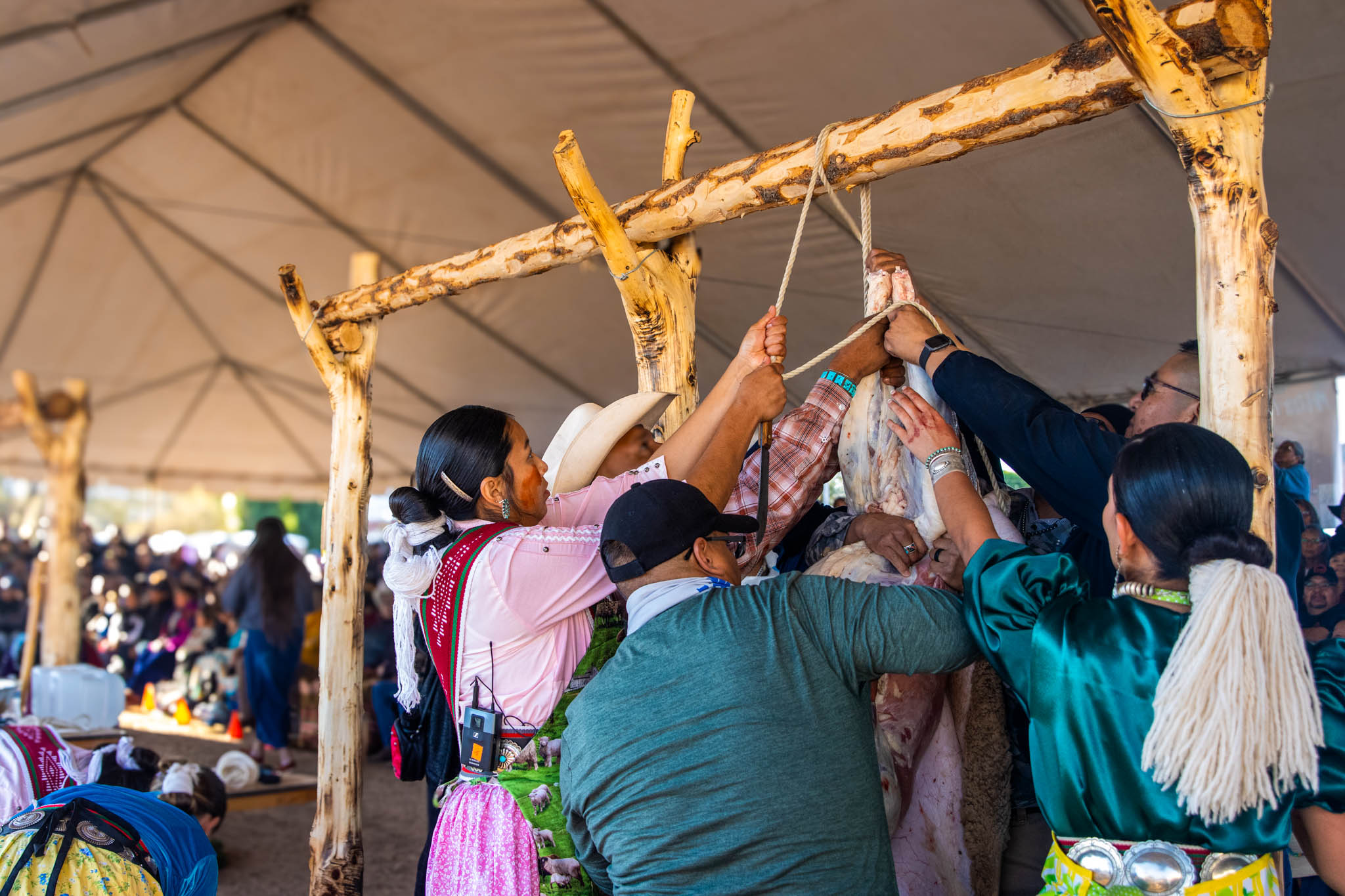Cronkite News Editor’s note: This article contains images of animal slaughtering.
PHOENIX, Arizona — By 7 a.m. on a Monday in early September, hundreds of people – some of whom had come out as early as 3 a.m. and traveled from states thousands of miles off – had gathered in the small town of Window Rock to watch the first day of the Miss Navajo Nation pageant. The building where the event took place was filled to capacity almost as soon as attendees were allowed in, and hundreds more set up lawn chairs behind a roped off area to watch the pageant.
All eyes were cast on the six young women competing. Cheers erupted as they came out, waved to the crowds and took their spots by large wooden butchering stands, tied-up sheep close by. Behind them were kindling fires they had to start without the use of lighter fluid.
“Miss Navajo Nation – she’s the bridge between the generations of the old and the young,” said Amy Naazbah Reeves-Begaye, 26, who was selected as queen in 2023 and reigned until the end of this year’s pageant.
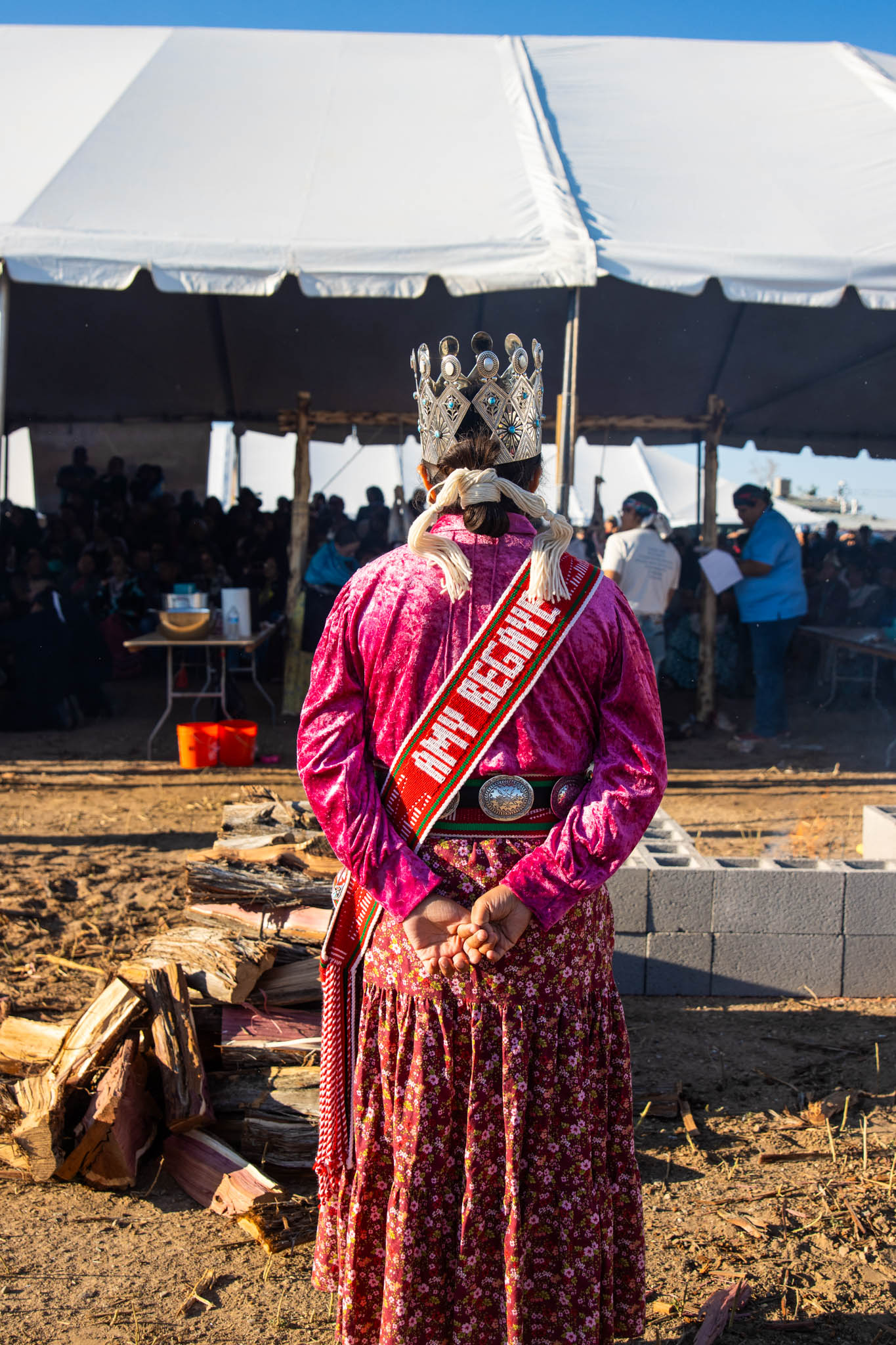
The pageant is an annual competition, where a new queen is chosen each year. Unlike most pageants, Miss Navajo Nation looks for the beauty “within oneself,” not merely physical beauty. The event also goes beyond just pageantry – the elected Miss Navajo Nation becomes a representative of the Navajo people, and she wields a strong political influence in the tribal nation.
“We are the only Native American nation to have royalty,” said Jonathan Hale, a former Navajo Nation Council delegate and current Head Start administrator who was the announcer for the pageant.
This was the 72nd year of the annual Miss Navajo Nation. Though the pageant has gone through changes, the focus has remained the same: to empower young women throughout the Navajo Nation and uphold Diné traditions so that they do not become lost.
Miss Navajo Nation is tasked with promoting Navajo culture and language. This was reflected in 1963, when the dual titles for “Miss Traditional Navajo” and “Miss Modern Navajo” were merged back to a singular title, representing the crucial role Miss Navajo Nation must play in leading her nation forward but still preserving traditional customs critical to Navajo identity in the modern age.
As a matrilineal society, a Navajo person’s clan and lineage comes from their mother. Traditionally, women have been thought of as the heads of their households and hold reverence in the Navajo Nation. The Miss Navajo Nation queen represents the cardinal role of “grandmother, mother, aunt and sister,” acting as an important familial figure and friend to the Navajo people.
“Growing up, you think of Miss Navajo as this woman that really can do anything,” said Navajo Nation President Buu Nygren. The pageant “just really showcases how strong and resilient our Navajo women are.”
It’s also a way to celebrate and encourage other Navajos to learn homesteading and traditional ways of life.
“It’s a way for our people to recognize and continue to celebrate our way of life – singing our songs, speaking our language, learning about how food is prepared, butchering,” Nygren said.
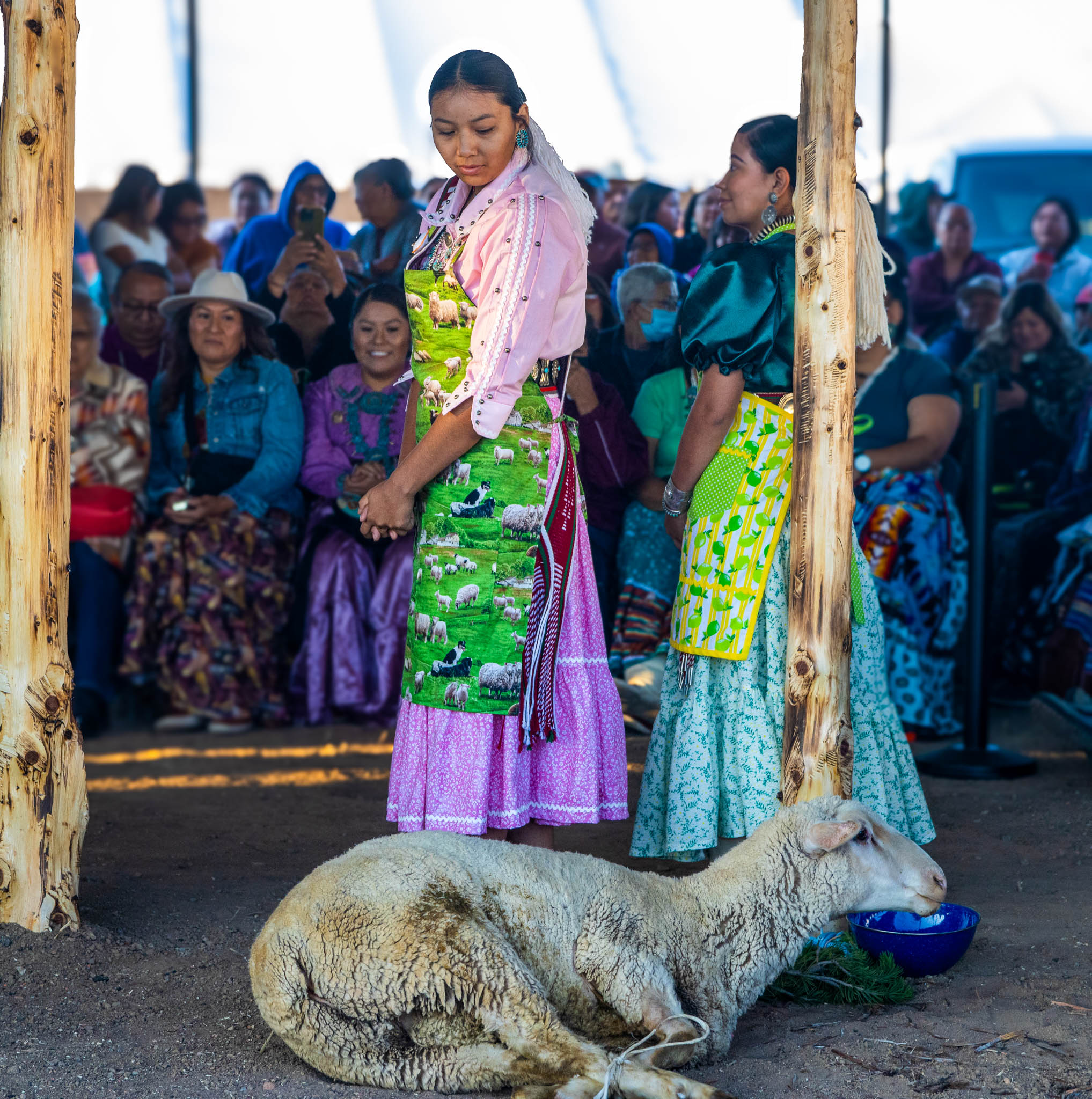
The women’s first big competition of the pageant: butchering a live sheep.
Sage is used to bless the sheep and give thanks for the animals’ lives before the competitors slaughter them. The women use a sharp knife to slit the sheep’s throat, lessening the suffering of the animal and providing a quick death. They only have one hour to butcher their sheep.
Each of the women were assisted by young volunteers, many of whom were also titleholders of various lower-division pageants throughout the Navajo Nation.

During the butchering, the women work methodically – despite the time limit, the sheep butchering competition is not about speed. It’s about precision and skill. Sloppy cuts could cost the women points from the judges and be seen as disrespectful to the sheep – animals are highly regarded in Navajo culture.
“This is the most challenging – mentally, physically, emotionally and spiritually,” Dayhenoa Ch’ikeeh Nizhoonii Yazzie, 20, said about the sheep butchering competition. Yazzie has held numerous pageant titles, including Miss Western Navajo 2022-23, and is currently studying at the Diné College for her bachelor’s degree in science public health.
Begaye won the sheep butchering contest when she competed in 2023. She had little experience with butchering prior to joining the pageant, and in preparation she slaughtered 18 sheep ahead of her first competition.
“Within our culture, the livelihood of some of our peoples still – they do take care of the sheep, and they do use that as a main food source,” Begaye said. “Butchering a sheep isn’t really a common thing now, so as we’re going into the next generation, I stand by that our young girls should understand that this is, in a sense, a basic necessity that they should know.”
The competition is a testament to their resilience. During the sheep butchering competition, Kiana Omi Toadlena sustained serious burns to one of her arms, and Quandinna Cheyanne Begay had to temporarily leave the competition to get stitches on a hand. But both persevered throughout the rest of the competition and pageant.
Begaye was present for the entirety of the pageant and during the sheep butchering contest, she could be seen offering words of encouragement to the competitors. Whenever the women started to falter from their laborious task, the announcer would urge them to continue forward.
“Keep going, just keep going,” Hale chanted.
Dark flecks of blood could be seen across the women’s pink blouses and skirts as they continued butchering. Niaomi Ranae Benally, 18, the youngest competitor at this year’s pageant, donned red ochre clay on her face – which is called chííh. It has long held spiritual significance with the clan Benally belongs to, the Tł’ááshchí’í, or “Red Bottom Clan,” who have used it for sacred ceremonies.
“Go, Niaomi, go!” her family members frequently yelled from the audience.
When the hour was up, the women were instructed to begin cleaning the intestines of the sheep and preparing for the second competition of the pageant’s first day, the traditional cooking competition.
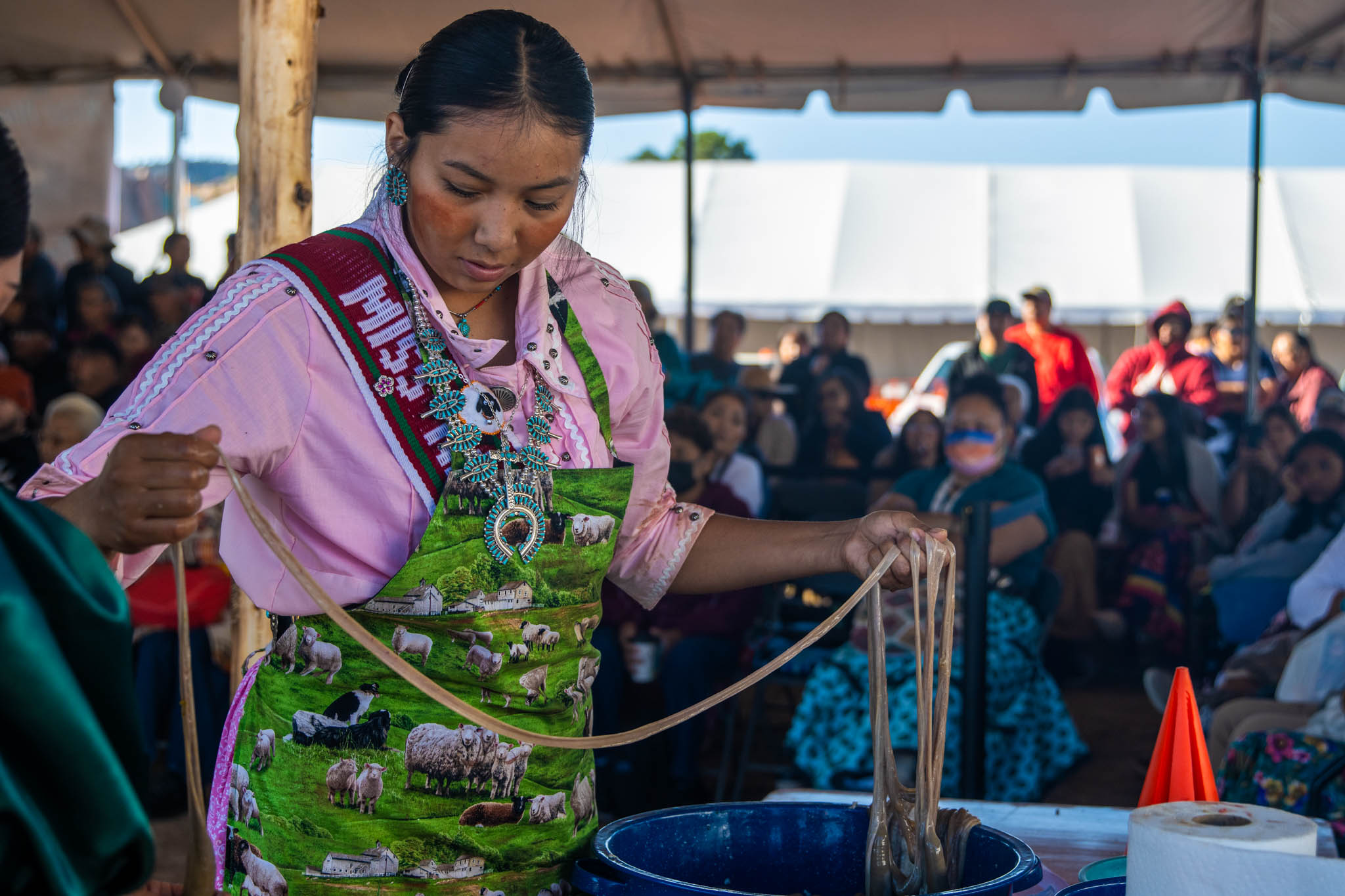
For this portion, Begaye explained, the pageant’s traditional coordinator assigned each of the women a traditional cuisine they had to prepare using parts of the sheep.
After the first day, the women had four more competitions ahead of them throughout the week: A business interview competition, a Navajo traditional knowledge competition, a contemporary skills and talent competition, and a traditional skills and talent competition.
“My ancestors did not survive a millennial of genocide for me to do the bare minimum,” Toadlena, 24, said during the pageant. On the third day, the women participated in a traditional and contemporary skills competition. Competitors went on stage and demonstrated two different skill sets – one of which is directly tied to Navajo traditions, and one modern skill.
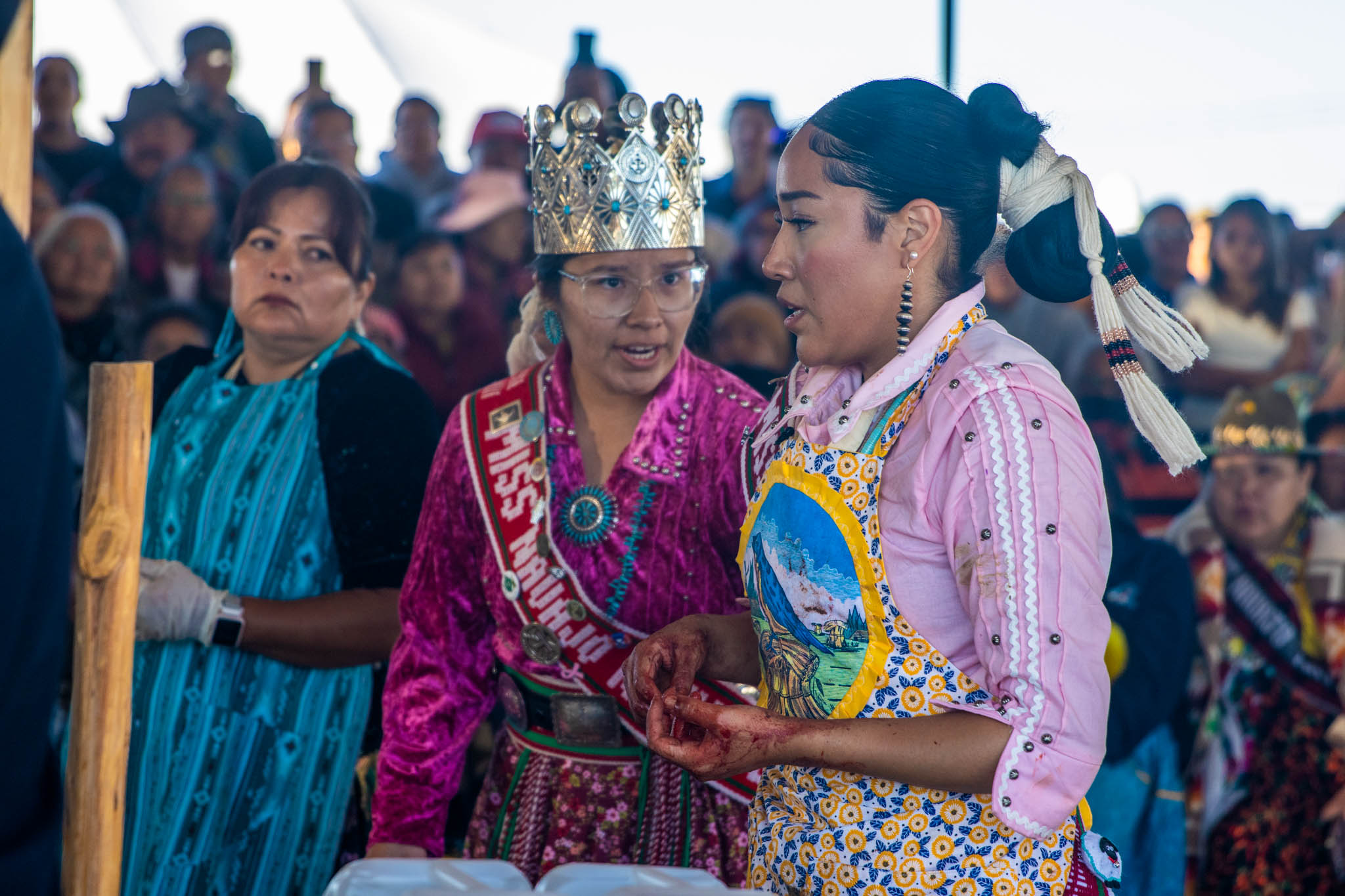
Toadlena had already made a name for herself in the Navajo pageant world as a child, reigning as the Tséhootsooí Diné Bi’ólta Little Queen, the Miss Tséhootsooí Middle School and Miss Window Rock High School before moving to attend school at Northern Arizona University as a first-generation student, where she studied health science. “I always do the bare maximum,” Toadlena said.
Taneesha Francis, 19, showcased her artistic side when presenting on the pageant’s third day. For traditional skills, Francis spun sheep wool to make yarn. Afterward, she demonstrated her crocheting skills as part of her contemporary skill set.
To compete for Miss Navajo Nation, women have to be unmarried, have no dependents, be between the ages of 18 and 25, be an enrolled member of the Navajo Nation and have a high school diploma or GED equivalent.
Before the competition, the women have to self-isolate for a week and can’t communicate with loved ones. This isolation acts as both a spiritual cleansing and reflecting practice, allowing the women to prepare themselves for the challenging week, and the responsibilities they will take on representing the Navajo Nation.
The contestants are expected to be fluent in the Diné language and culture. Diné translates to “the people.”
Judges gruelingly test the women on their Navajo fluency as they cut and prepare their sheep. The women have to reply back with fluency; if the competitors stumble in their Navajo or switch to English when responding, or don’t give satisfactory answers, the judges will dock them points.
“If selected as Miss Navajo, one of my biggest accomplishments is to preserve language, tradition and culture for the younger generations to come,” said Quandinna Begay, 23, who had earlier gotten stitches in the sheep butchering competition. “Because – for me, at least – it is hard to learn our language.”
Navajo language is considered endangered by linguists and only had around 170,000 speakers left in the country in 2019, according to the U.S census.
Loss of Navajo language can be traced back to assimilatory boarding schools, which thousands of Navajo children were forced to attend between 1869 all the way up to the 1960s. Students were often beaten or punished if they spoke their native languages.
Despite this, the number of Navajo speakers has steadily increased since the 1980s.
“I can truly say that the people in my generation, we are making an attempt to preserve our culture,” said former queen Begaye. “With myself, I’m not fluent in the language. But when I came into this position, it was a requirement. And I thought, ‘OK, I have to learn. I have to be open. I really have to do this.’”
Begaye said seeing both her generation and those younger than her actively trying to learn and speak Navajo and preserve the traditional Navajo way of life makes her “hopeful.”
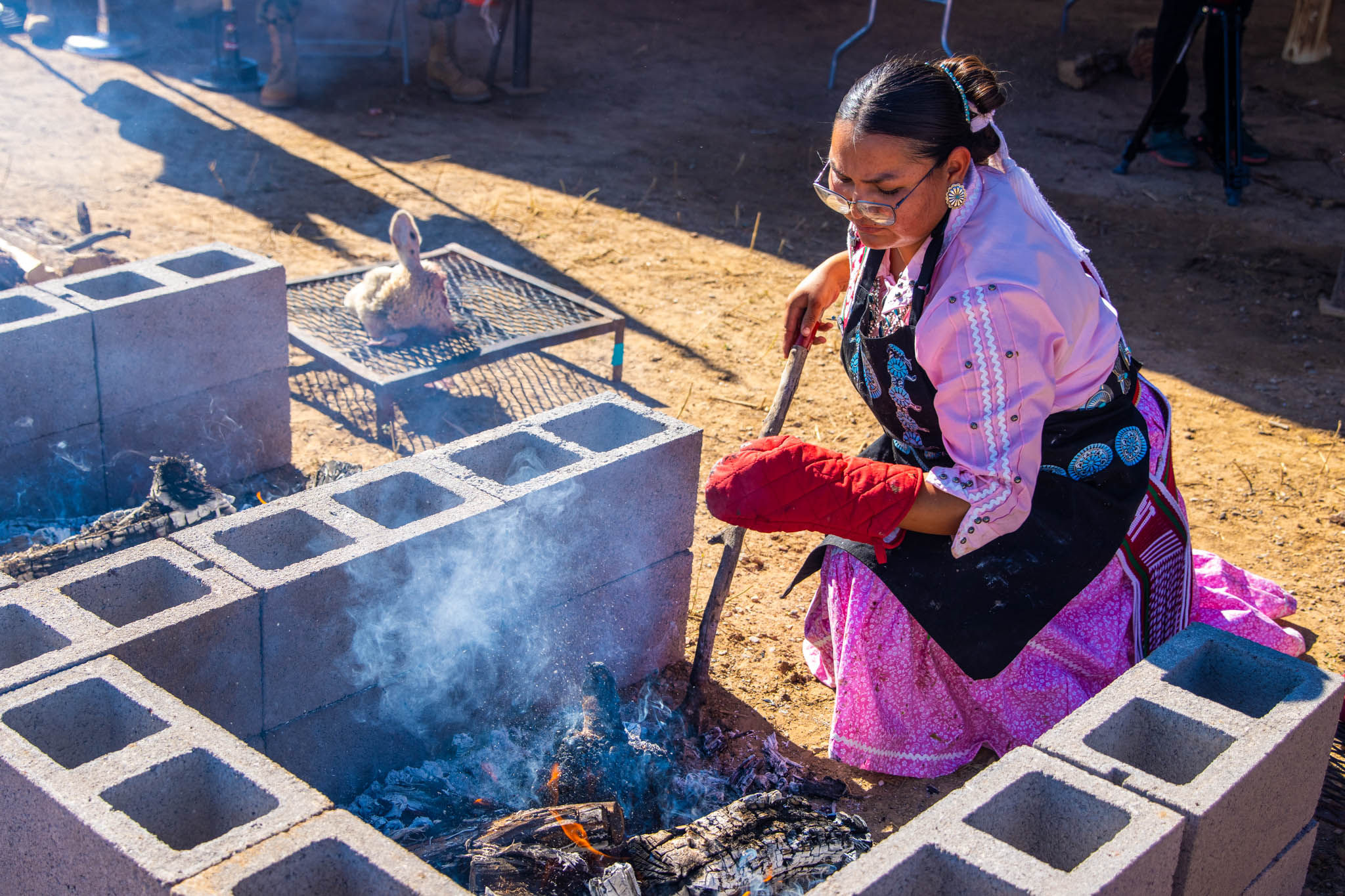
Miss Navajo Nation isn’t just a pageant winner. She also becomes the goodwill ambassador for the Navajo Nation. She serves as a role model for the largest Native American nation in the United States, which spans across Arizona, Utah and New Mexico and has 110 chapters.
During her time as queen, Begaye has traveled around the country to represent the Navajo Nation. Begaye spoke to Big 10 universities to establish Native American centers and foster communities for Native American students. She traveled to Washington, D.C., earlier in the year to speak with members of Congress about the importance of the Supplemental Nutrition Assistance Program (SNAP) and others for the Navajo Nation.
Begaye earned her undergraduate degree from Utah Tech University and is now a master’s student at Arizona State University studying to become a dietician.

“A lot of our kids, they sometimes become lost, and they need that little encouragement,” Begaye said. “So I did a lot of promoting higher education within the nation.”
In July, Begaye traveled to France and represented the Navajo Nation at the 2024 Paris Olympics.
“Some of the questions I was asked every now and then was, ‘Are you Peruvian? Are you Spanish?’” Begaye said, sharing how many people in Paris couldn’t tell what her ethnicity and culture were. “Having to explain, ‘Oh, I’m Native American,’ and having to share that part of my hometown with Europe was really nice.”
“I heard Amy went to Paris,” Miss Baker Middle School Nala Nelson, 12, said to the audience. “She let the Paris people know that the Navajo Nation is still here and that we still talk our Navajo language.”
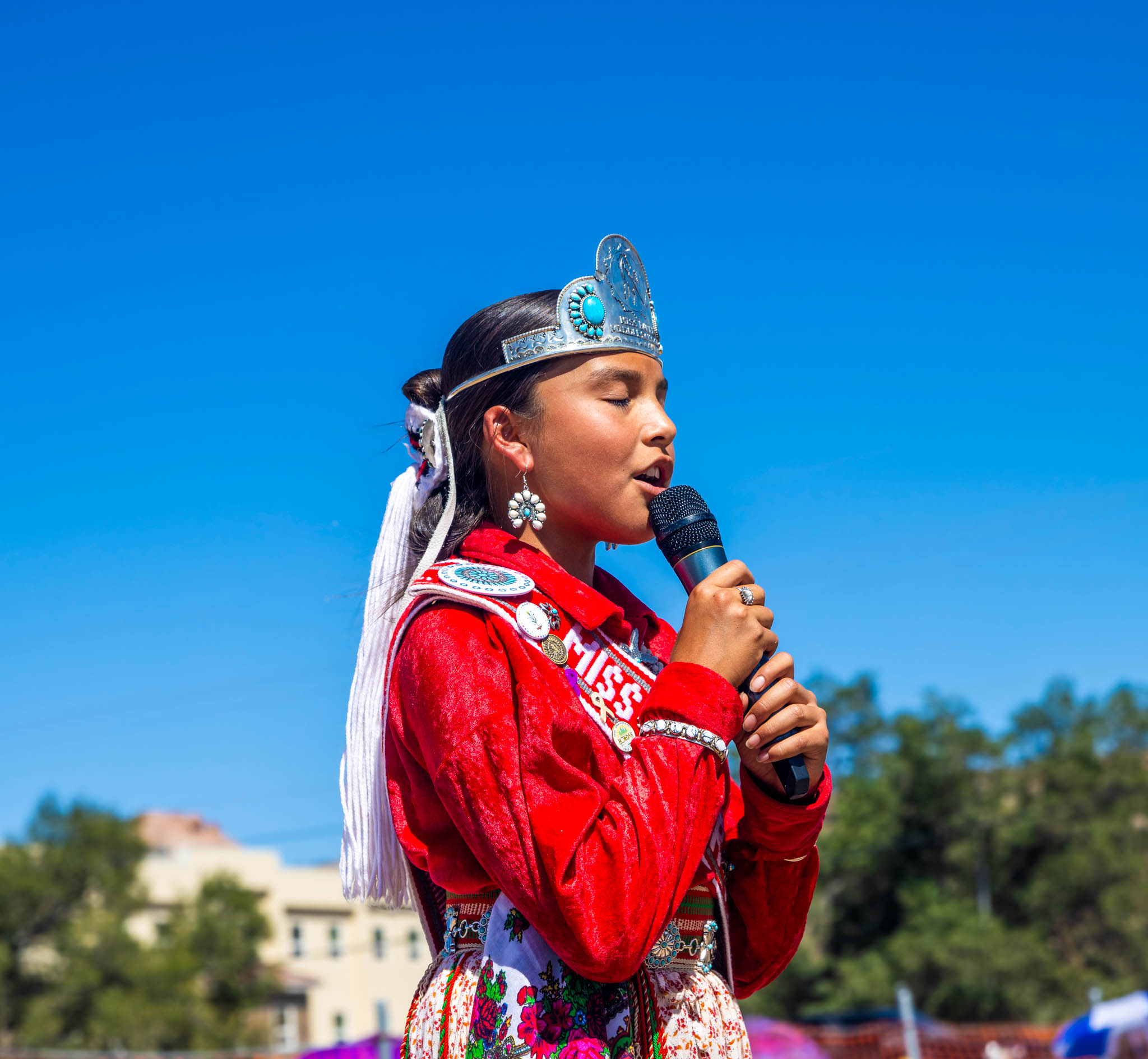
Besides education, Begaye has used her platform to promote health and wellness for the Navajo Nation.
Begaye’s grandfather was one of the many Navajo workers who developed cancer and other serious health conditions from working in uranium mines – health effects the U.S. government had failed to make Navajo workers aware of. Begaye said her grandfather’s plight was a heavy influence on her decision to go into the health sector and promote wellness for her people.
First lady of the Navajo Nation and former Arizona Rep. Jasmine Blackwater-Nygren, who sat front row with her husband during the first day’s pageant, called Miss Navajo Nation a “coveted role.”
“It’s nothing like I’ve seen in other tribal communities or even communities that I’ve visited,” Blackwater-Nygren said. “We call them royalty, but they’re kind of like cultural ambassadors.”
“There’s a lot of younger titleholders that are here,” Blackwater-Nygren said, gesturing to the dozens of young girls – some of whom were volunteers – wearing brightly colored traditional dresses and crowns similar to the one Miss Navajo Nation wears.
“It’s really big in middle school, high school, and then we have the regional pageants as well. There’s a Miss Northern Navajo, a Miss Eastern Navajo, a Miss Western Navajo. And then Miss Navajo is kind of like the ultimate titleholder. So a lot of the young titleholders that are here – that’s their long term goal, to become Miss Navajo,” Blackwater-Nygren said.
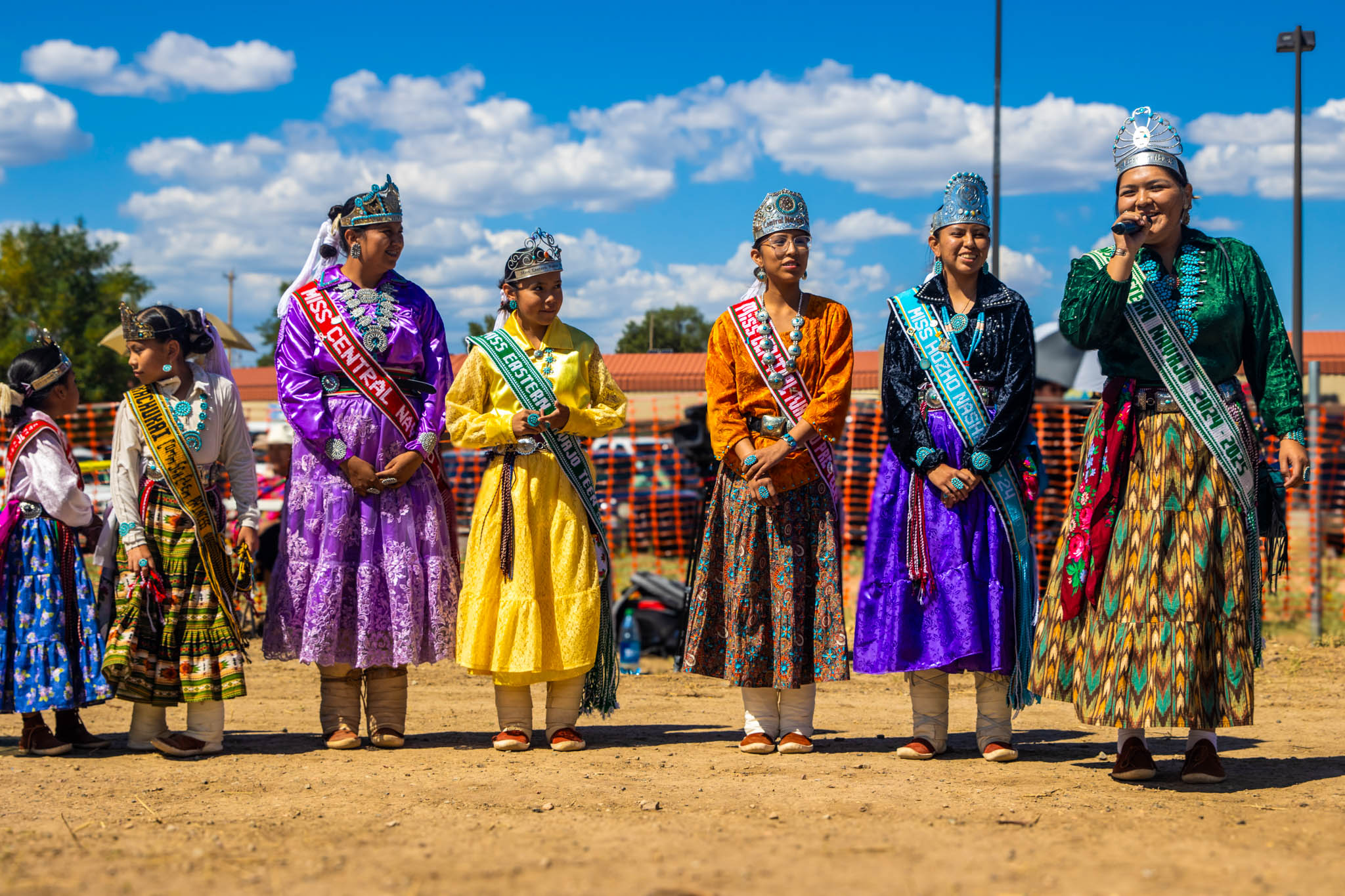
Terilynn Charley, 19 is the reigning Miss Eastern Navajo.
“This is a lot tougher than what I went through,” Charley said. “But it does give me an eye-opener on what’s ahead of me and what I could be doing later on in the future,” she continued, saying she wouldn’t rule out the possibility of trying to compete later on for Miss Navajo Nation.
Charley also liked the immediate impact of the pageant on the youths who attended.
“I really do like how there were a lot of little kids here, and I did hear how in the stands, ‘Oh Mom, how do I do this? How do I do that?’ And I really do like that because they’re teaching them,” Charley said. “My message to them would be to overcome their fears; we all try new things.”
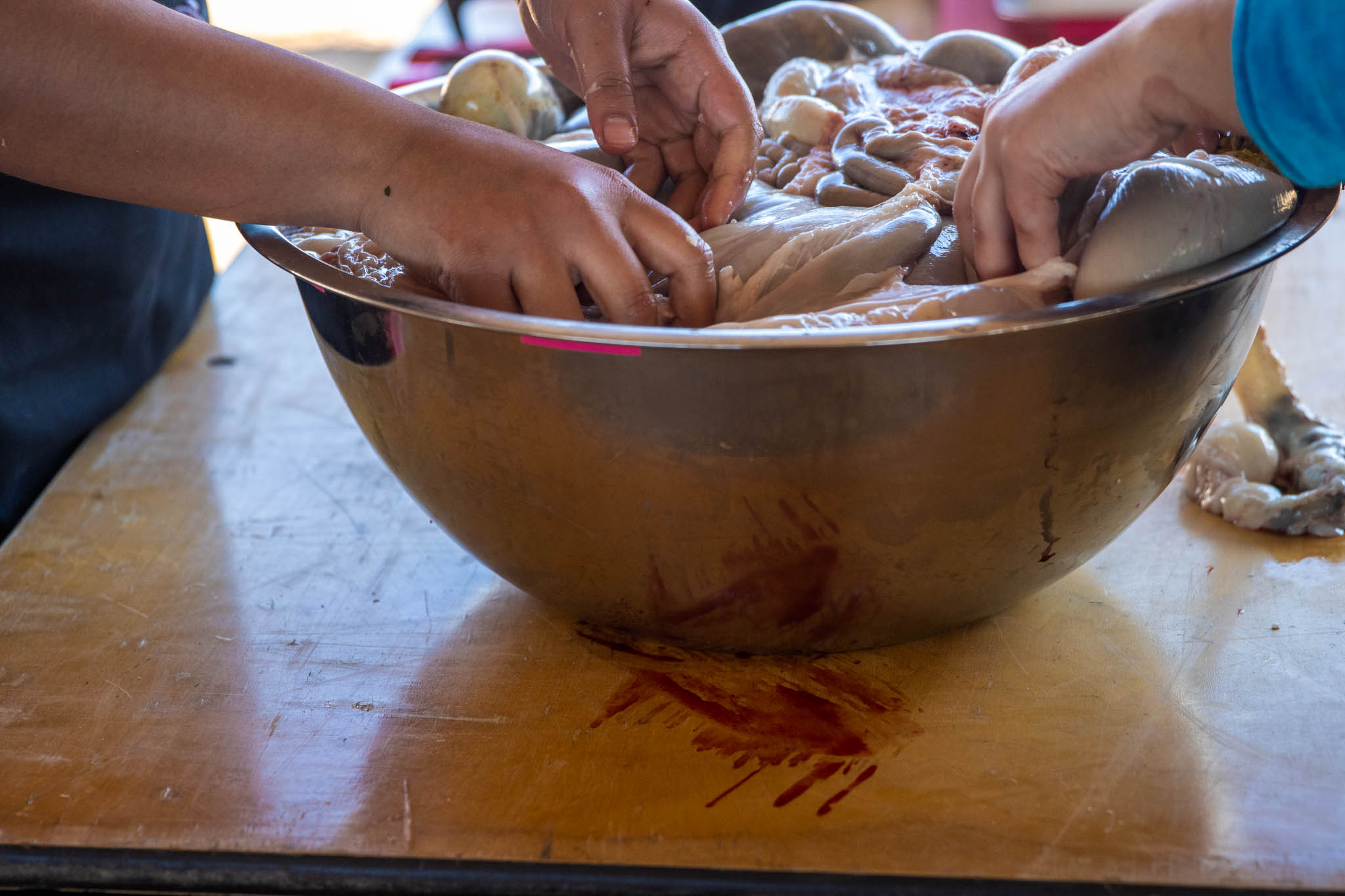
The importance of teaching was reiterated throughout the pageant. As the women were butching, they were encouraged to explain the process to their young volunteers, and the audience was implored to educate their children on the practices.
“This experience is a valuable education. Keep it alive, keep it a good practice. Carry on tradition,” Hale said to the crowd.
“A lot of the social challenges that we face across Navajo – like alcoholism, drug addiction, kids that are by themselves or foster kids – that all comes back from building that strong foundation,” Nygren said.
On the last day of the pageant, Ranisha Chrislyn Begay, 23, was crowned the 72nd Miss Navajo Nation. She had won the traditional foods and best-essay competitions earlier in the competition.
“I am very proud and honored to be part of the Miss Navajo Nation contest,” Ranisha Begay said shortly after completing the sheep butchering contest on the first day of the pageant. “It’s a very big opportunity to present what I know and what I’ve learned from my family, from my parents and grandparents.”
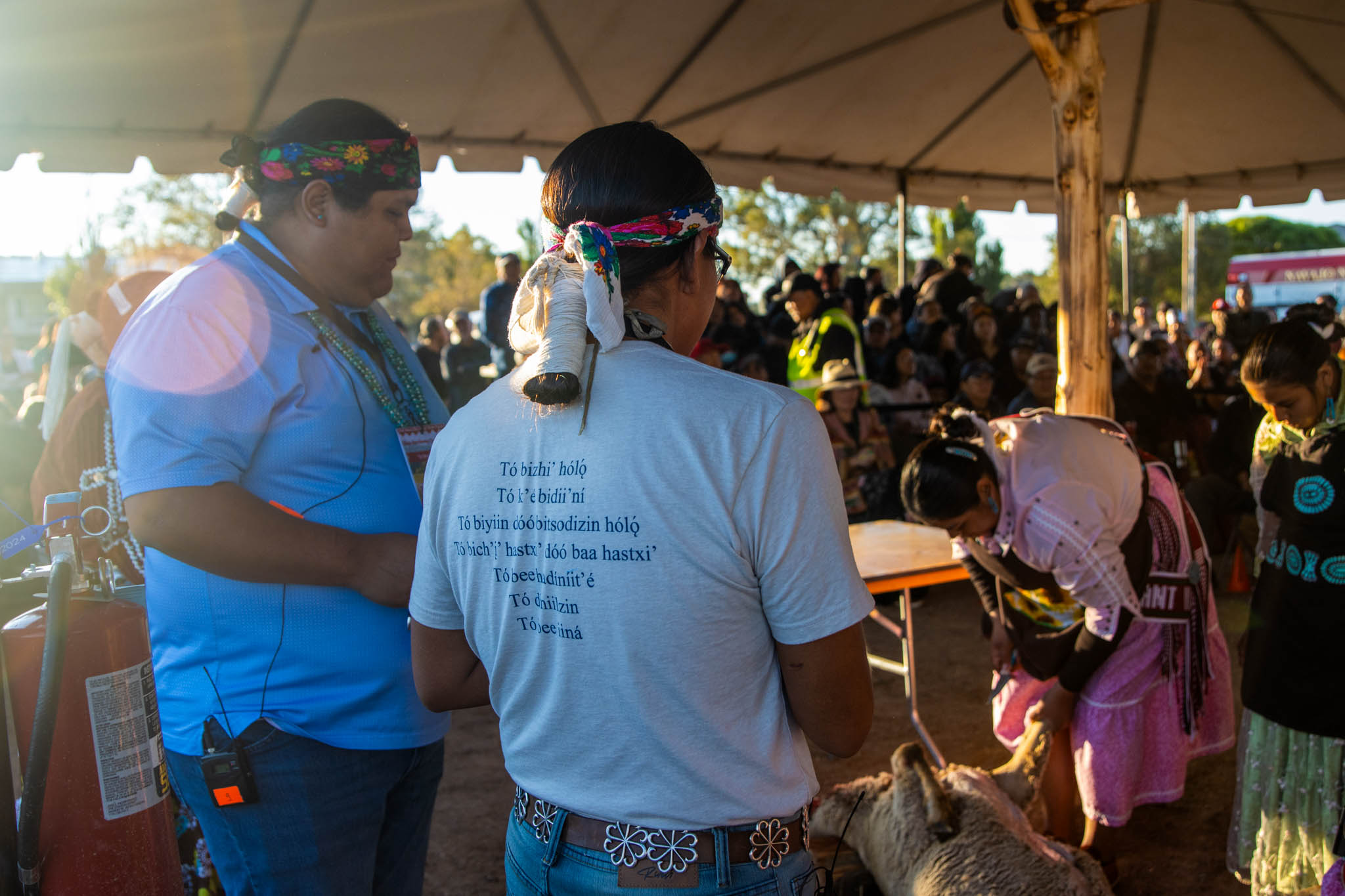
Ranisha Begay said she enjoyed being questioned by the judges, as it allowed her to “reflect” on the teachings that her elders had shared with her. “A lot of those questions are what they shared with us as we were butchering with family,” she said.
As Miss Navajo Nation, Ranisha Begay said she would use her platform to continue to encourage youth to learn about their culture and the Diné language.
“I think that’s the most important thing that we have as Diné people,” she said. “We have lost so many ceremonies, prayers, and all we have to do is continue to uphold what we have left for our youth.”
“That is what brings power to our Navajo people and reflects who we are as people.” she continued.
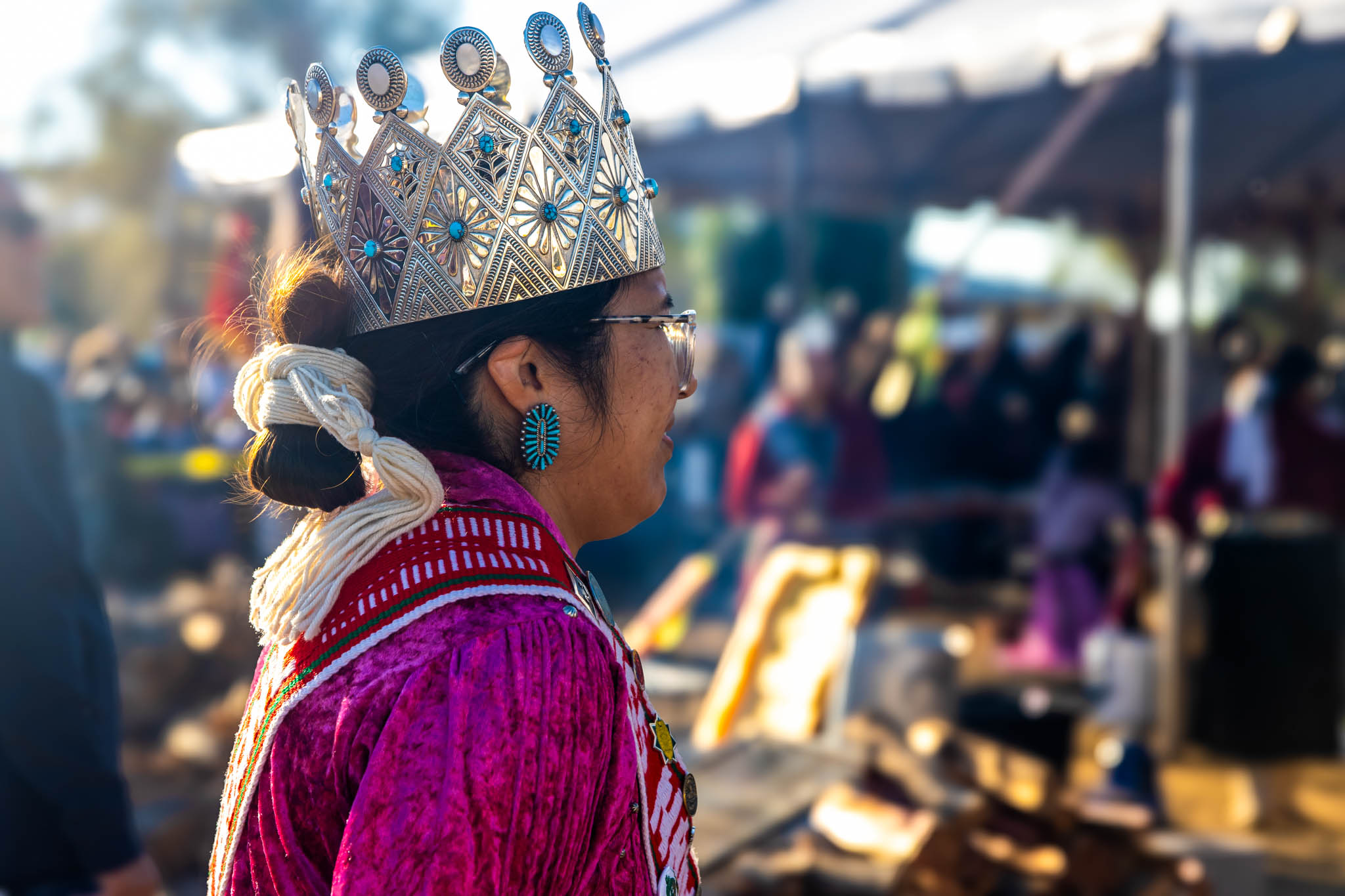
For the next year, Ranisha Begay will be the one to wear the Miss Navajo Nation crown, which weighs two and a half pounds and is pure silver, adorned with turquoise and imbued designs that hold deep religious and spiritual significance to Diné people. Various parts of the crown pay homage to female deities including Yoolgai asdzáá, or “White Shell Woman,” billed as the creator and sustainer of life; Asdzą́ą́ Nádleehé, or “Changing Woman,” who is said to have created the first Navajo people and represents fertility and rejuvenation; and Na’ashjé’ii Asdzáá, or “Spider Woman,” who is believed to have woven the web of the universe.
“I just wanted to thank each and every single one of you. We made it through the week,” Ranisha Begay said, acknowledging the five other women she competed alongside. “I know each of you knows something special that your parents shared with you, and you presented that well.”
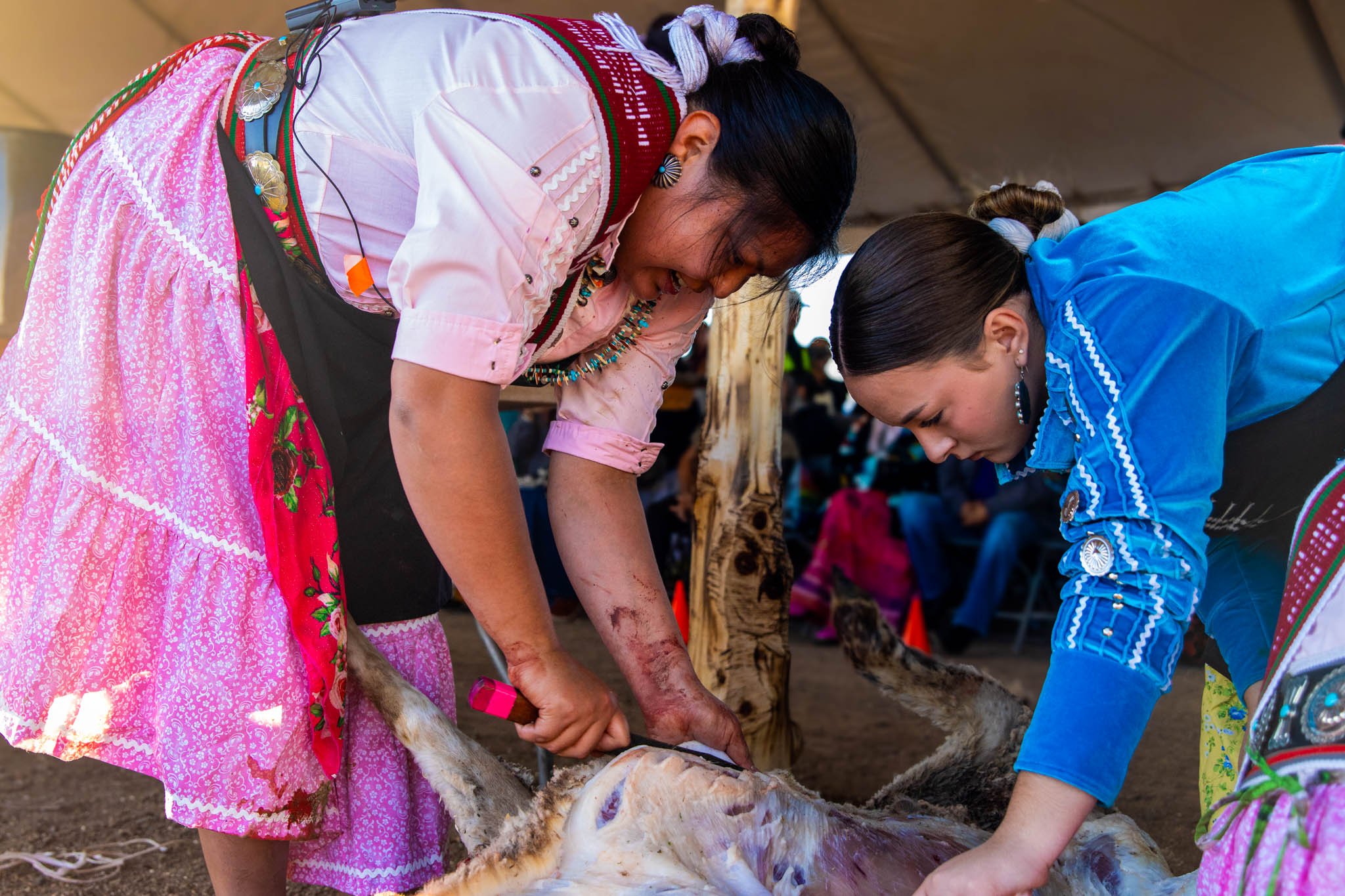
Note: This story originally appeared on Cronkite News. It is published via a Creative Commons license. Cronkite News is produced by the Walter Cronkite School of Journalism and Mass Communication at Arizona State University.
Chuck Hoskin: Cherokee Nation celebrates Cherokee women
Native America Calling: Tribal rights, a new restaurant and more are on The Menu
Native America Calling: Tribes vie for better access to traditional plants
Senate committee schedules confirmation hearing for Interior nominee
Fact Sheet: Department of Health and Human Services to undergo ‘dramatic restructuring’
Press Release: Department of Health and Human Services to undergo ‘dramatic restructuring’
Native America Calling: The new Social Security reality for Native elders
Montana Free Press: Hip-hop artist Foreshadow celebrates latest release
Cronkite News: Bill creates alert system for missing and murdered relatives
Bureau of Indian Affairs approves HEARTH Act regulations for Mohegan Tribe
House Subcommittee on Indian and Insular Affairs sets field hearing for self-determination anniversary
Native America Calling: Sometimes, COVID doesn’t go away
Native America Calling: The changing landscape for subsistence hunting and fishing
Press Release: AIHEC ‘deeply concerned’ about closure of Department of Education
More Headlines
